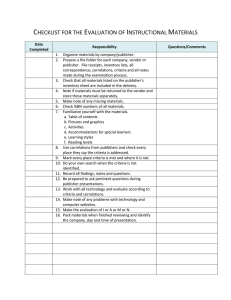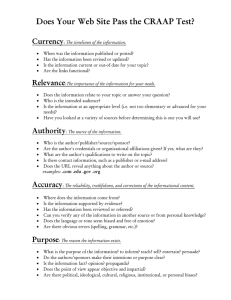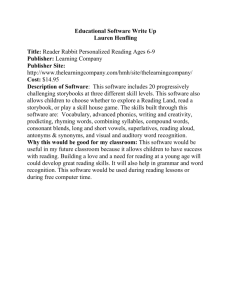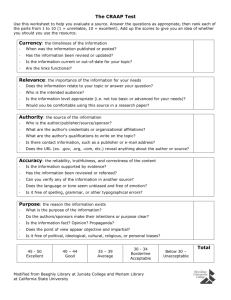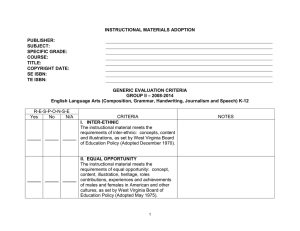C E I M
advertisement
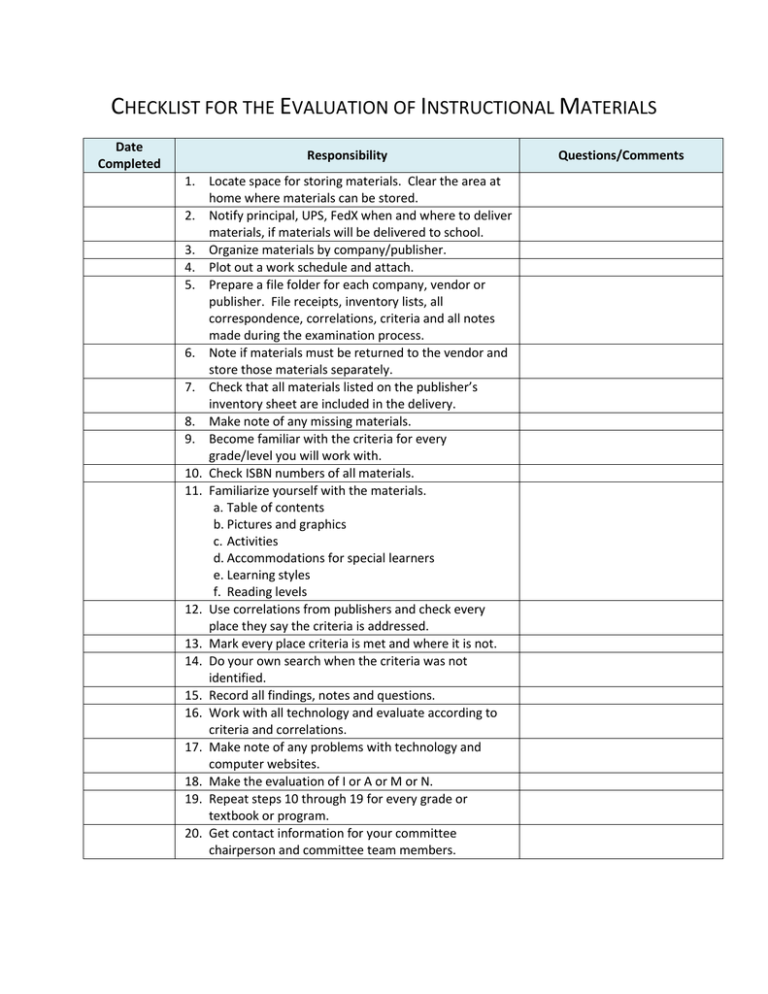
CHECKLIST FOR THE EVALUATION OF INSTRUCTIONAL MATERIALS Date Completed Responsibility 1. Locate space for storing materials. Clear the area at home where materials can be stored. 2. Notify principal, UPS, FedX when and where to deliver materials, if materials will be delivered to school. 3. Organize materials by company/publisher. 4. Plot out a work schedule and attach. 5. Prepare a file folder for each company, vendor or publisher. File receipts, inventory lists, all correspondence, correlations, criteria and all notes made during the examination process. 6. Note if materials must be returned to the vendor and store those materials separately. 7. Check that all materials listed on the publisher’s inventory sheet are included in the delivery. 8. Make note of any missing materials. 9. Become familiar with the criteria for every grade/level you will work with. 10. Check ISBN numbers of all materials. 11. Familiarize yourself with the materials. a. Table of contents b. Pictures and graphics c. Activities d. Accommodations for special learners e. Learning styles f. Reading levels 12. Use correlations from publishers and check every place they say the criteria is addressed. 13. Mark every place criteria is met and where it is not. 14. Do your own search when the criteria was not identified. 15. Record all findings, notes and questions. 16. Work with all technology and evaluate according to criteria and correlations. 17. Make note of any problems with technology and computer websites. 18. Make the evaluation of I or A or M or N. 19. Repeat steps 10 through 19 for every grade or textbook or program. 20. Get contact information for your committee chairperson and committee team members. Questions/Comments General Guidelines 1. Organize all materials when it arrives at your home. 2. Check inventory to see that all items were included in the shipment. 3. Do an initial review when the materials arrive to identify areas of concern that will need to be clarified by the publishers in order for you to effectively review their materials. 4. Relay any questions and/or concerns to your committee chairperson by June 20, 2008. Your initial findings will be used to structure any hearings that may be necessary during the July Deliberations. 5. Complete one grade/level/publisher/textbook before you begin another. 6. Focus your review on the teacher’s edition (TE) first and then move to the student edition (SE). Additional resources sent to you should only be included in the official review of materials if the TE and SE do not meet the identified criteria. If the combination of the TE and SE fall short of the requirements, expand your review to the additional resources. Note which additional resources are needed if the program is to meet the requirements to be listed as a primary material. 7. If correlations are made to any items other than the TE and SE, those items may be included in the initial review; however, those items must be provided free of charge with every SE and/or TE purchased. 8. Organize all of your materials/documents in file folders. 9. Keep all notes and comments made during the review process. This will be valuable during the deliberations. 10. Remove your opinion from the evaluation process. 11. All materials are to be evaluated according to the criteria. One publisher’s materials should not be compared to another publisher’s materials. 12. Review all materials assigned and be prepared to explain and/or defend your evaluation in July.
